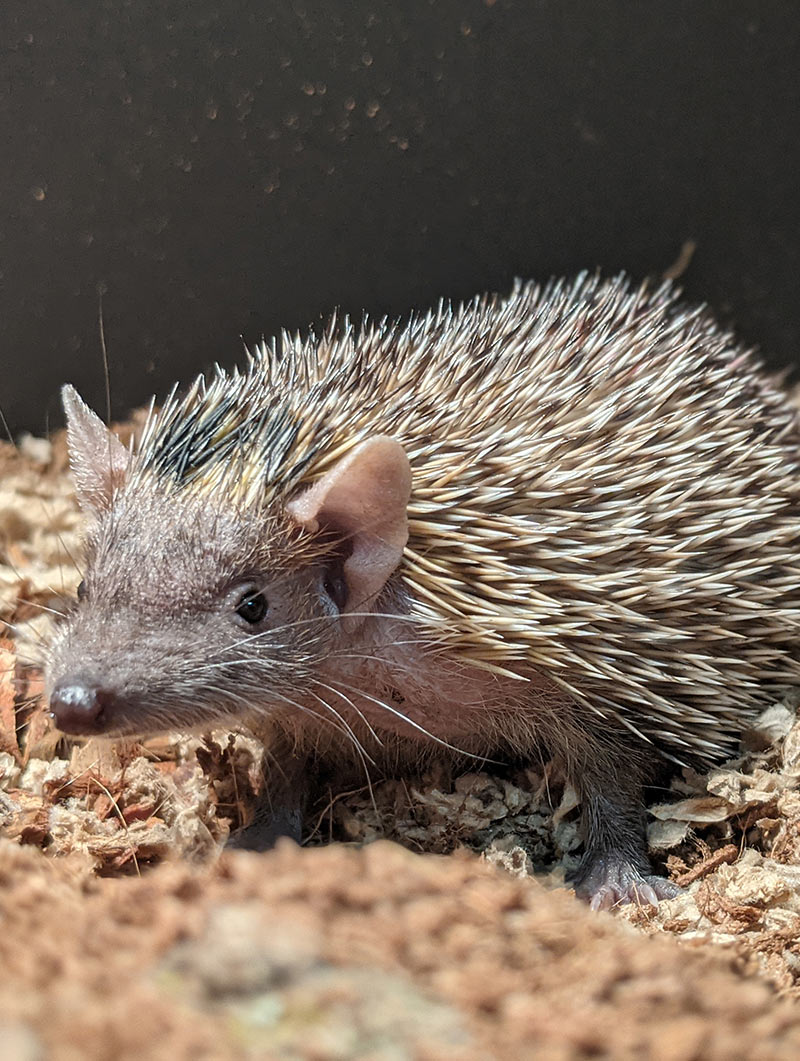Photo by Kmiecik Imagery
Lesser Madagascar Hedgehog Tenrec
Echinops telfairi
Description
Lesser Madagascar hedgehog tenrecs have spines that cover their back and sides. They have softer hair on their face, legs, and belly. Individuals vary in color from light to dark brown.
Size
Lesser Madagascar hedgehog tenrecs weigh 4-7 ounces (113-225 grams) and grow between 5.5 and 7 inches (14-18 centimeters) in length.
Adaptations
- Tenrecs are nocturnal and have senses that are well developed for life in the dark. They have very sensitive whiskers to help them navigate in the dark and excellent senses of hearing and smell which help them to find food. Unlike many other nocturnal animal species, tenrecs have poor eyesight.
- When threatened, tenrecs curl into balls to expose their spines and protect their heads and bellies. If further agitated, it is not uncommon for tenrecs to defend themselves further by biting at and even lunging backwards into predators, driving their spines into the offensive animals.
- During the cooler season in Madagascar (May to October), tenrecs’ preferred food items may become scarce. To save energy, tenrecs go into torpor, a state of hibernation-like inactivity.
- Lesser hedgehog tenrecs are good climbers. Their feet are equipped with long toes and tiny hooked nails, which allow them to climb on many types of natural surfaces.
Diet
In the wild, lesser Madagascar hedgehog tenrecs are opportunistic feeders eating much of what they find foraging on the ground. The main part of their diet consists of small invertebrates, like insects and larvae. They will also eat fruit and other small animals, such as baby mice and bird eggs. At Cosley Zoo, the tenrec eats a combination of vegetables, fruits, insects, mealworms, earthworms, hard-boiled eggs, and a processed insectivore (insect-eater) diet.
Reproduction
Mating begins when lesser Madagascar hedgehog tenrecs emerge from torpor, usually in October. After a gestation period of 61-68 days, a litter of one to ten relatively undeveloped young are born. The babies grow quickly, however, and become independent after only one month.
Shelter and Space Needs
Tenrecs are found in the arid regions of southern and southwestern Madagascar, where they live both on the ground and in trees in dry spiny forests (habitats unique to Madagascar) and open grasslands. During the day, tenrecs shelter in tree cavities.
Life Expectancy
Lesser Madagascar hedgehog tenrecs can live up to 8-10 years in the wild, and about 13 years in human care.
Relationship With Man
While lesser Madagascar hedgehog tenrecs are currently a species of least concern with stable populations, habitat loss is a great threat to most tenrec species. The island of Madagascar loses thousands of hectares of forest each year to logging and slash-and-burn agriculture.
Fun Facts
- Lesser Madagascar hedgehog tenrecs are part of an Association of Zoos and Aquariums (AZA) Species Survival Plan (SSP) program, which is a cooperative population management and conservation plan. The goal of the SSP is to maintain a healthy and self-sustaining population.
- The closest relatives to the tenrec family are otter shrews and golden moles, not hedgehogs as their name suggests.
- An early tenrec species is thought to be the first mammal to settle on the island of Madagascar around 60 million years ago!
- As early placental mammals, tenrecs have some primitive characteristics that many more recent placental mammals have lost. These primitive traits include a relatively low body temperature and the retention of a cloaca, a single reproductive, intestinal, and urinary opening. Typically, egg-laying mammals, birds, and reptiles have cloacas, but not placental mammals.
- There are almost 30 different tenrec species.
- Tenrecs make many different sounds including hisses, grunts, twitters, and even echolocation clicks made with their tongues to help them navigate their environments and find food. Some tenrec species also communicate by rattling their spines.






